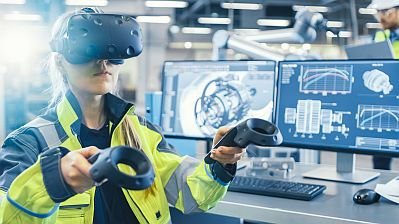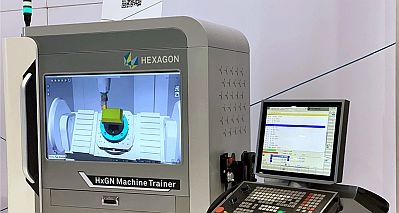Will AI Fix Manufacturing's Labor Gap?
The manufacturing industry is facing significant labor and skills shortages. This introduces many challenges for businesses, such as production delays, higher operational costs, and higher burnout rates among employees due to increased workloads. Steve Ilmrud, Hexagon’s VP of Operations, writes that, increasingly, manufacturers are turning towards artificial intelligence (AI) to address these challenges and reshape employees' skill sets.
While still in its infancy, AI-powered tools and technologies are already transforming factories across the globe by helping to enhance efficiency, streamline training processes, and ultimately create safer, more productive work environments.

An AI tool -- Hexagon's Leica BLK ARC -- is an autonomous laser scanning solution used on self-navigating robotic carriers, with minimal human control. [All photos courtesy Hexagon Manufacturing Intelligence]
The manufacturing skills gap is driven by various factors, including an aging workforce and outdated negative perceptions about what it’s like to work in the sector. Many people still think the industry is low-paid, physically demanding, and has long working hours. Unfortunately, these perceptions can deter people from pursuing related qualifications. As a result, organizations are finding it difficult to hire qualified machinists and assembly technicians.
To address this shortage, rapid onboarding, training, and upskilling of new workers is crucial. One of the most effective ways to do this is to simplify the roles of workers by using technology to do the heavy lifting. While training workers to use complex equipment is time-consuming and expensive, teaching them to use AI is comparatively straightforward. Increasingly, the workforce is even adapting to expect access to AI-driven tools from the get-go.

In the future, experts anticipate an increase in augmented reality (AR) and virtual reality (VR) to further support training workers quickly and getting them up to speed.
To meet this need, several organizations are developing smarter technology that uses AI to handle complex tasks. This simplifies team members' roles and eases the onboarding process. It also significantly enhances the productivity and efficiency of trained workers within the industry.
AI-Powered Tools and Technologies
One key issue with manufacturing is the high cost of the tools and the potential hazards associated with using them -- especially if they are used incorrectly. To reduce the risk of these hazards, thorough training is essential. To address this without requiring factories to reduce productivity by taking machines offline, digital twin simulation solutions can help deliver the needed training while not hindering production.
One example is the Hexagon Machine Trainer, a virtual trainer designed to simulate multiple types of CNC and CMM machine interfaces. This allows organizations to train workers without disrupting operations, which doesn’t hinder productivity.

PC-DMIS is a measurement software solution that supports systems from CMMs to portable measuring arms and laser trackers.
Another challenge is that new workers often lack the skills required to make important decisions about how to perform tasks most efficiently. To solve this, Hexagon has developed intelligent machine tools that use AI to predict the best way to perform a task and make important decisions based on past use cases. This enhances productivity and empowers workers with minimal training to use the tools to make informed decisions while expediting their learning.
The way inspection routines are carried out is also changing. They have traditionally needed to be performed by experienced programmers, but Hexagon is enabling workers to improve quality control by using AI to automate inspection routines. For example, workers can easily upload CAD models to the software, which automatically generates the program. This automation promotes consistency and reduces the chance of issues slipping through the net.

HxGN Machine Trainer Workshop at Hexagon's Novi, MI facility. Manufacturers will need to invest in AI training to get workers up to speed quickly.
These advanced technologies are only some examples of the ways that Hexagon is working to bridge skills gaps across manufacturing organizations and promote safer, more productive work environments.
Training Programs and Skill Requirements
While AI is useful, it can't replace all of the critical skills required in manufacturing. Machinist skills are still some of the most in-demand skills -- but in different ways than before.
Manufacturing no longer requires the physical "elbow grease" that it once did. Today, we have specialized machines for that. As the industry becomes increasingly automated and factories integrate more intelligent AI-powered tools instead of outsourcing training, the need for these physical skills is being replaced with the requirement for software familiarity and confidence.
Modern AI-integrated tools are designed to simplify the training process so workers can hit the ground running more quickly. Already, many factories have reached the point where a worker can automate 90% to 95% of the process with the press of a single button, thanks to advances in technology.
Investment in AI Training
As the connection between increased AI usage and productivity in the manufacturing sector becomes more apparent, training and investments are rising significantly.

HxGN Machine Trainer at Safran Aircraft Engines' facility
Many factories are already demonstrating these benefits. For example, Hexagon’s AI-based Manufacturing Execution System (MES) tracks every worker's unique skill set and uses this information to optimize their placement in the factory.
The system also accounts for additional factors such as capacity planning, lead times, and work attendance. If an unexpected interruption occurs, such as a worker calling in sick or a part running out, the AI adapts its strategy accordingly. This data improves production planning and drives efficiency across the organization.
Real-World Applications of AI in Manufacturing
Much of this may sound futuristic, but AI is already being applied in manufacturing to increase operational efficiency and improve safety across the industry.
In some factories, AI scanners use heat sensors to identify potential health and safety incidents. If it detects a heat signature lying on the ground and not moving, the system may interpret that someone has fallen and raise an alarm.

ESPRIT EDGE software in use. Increasingly, manufacturing is becoming an AI-driven, software-led profession.
This feature is particularly essential during night shifts when fewer people are likely to be in the building. These sensors can also be used on automated production lines to identify when machinery may be going off track so it can be paused before damage occurs.
Another application of this technology is implementing AI sensors to monitor drivers and ensure their attentiveness. For instance, if the data suggests a factory driver has fallen asleep, a buzzer can alert them to wake up, preventing potential hazards. The equipment can also be used to autonomously control heavy equipment in scenarios where conditions are deemed unsafe for human workers.
Future of AI in Manufacturing
We're still only at the beginning of applying AI to manufacturing. Over the next few years, new emerging technologies are expected to change the industry in novel ways.
For instance, the industry anticipates an increase in augmented reality (AR) and virtual reality (VR) to further support training workers quickly and getting them up to speed. We also expect to witness the continued evolution of AI-powered simulations, like those described above, for use in training.

As the industry becomes increasingly automated and factories integrate more intelligent AI-powered tools, the need for physical skills is being replaced with software familiarity and confidence.
Meanwhile, it's anticipated that we'll continue to see a shift away from workers using physical labor and a move towards workers using software to carry out tasks and simulate interactions. Above all else, workers will need to be adaptable and prioritize continuous learning if they are to remain valued members of the workforce.
Staying Ahead of the Curve
To stay ahead of the curve and fill critical skills gaps, manufacturing organizations will need to invest in AI training to get workers up to speed quickly. Meanwhile, workers will need to adapt their skills to the changing needs of manufacturing organizations.
That will involve moving away from the outdated notion that manufacturing is a physical profession that requires strength and "elbow grease" and towards the idea that it is increasingly becoming an AI-driven, software-led profession.
Want more information? Click below.
Rate this article
View our terms of use and privacy policy